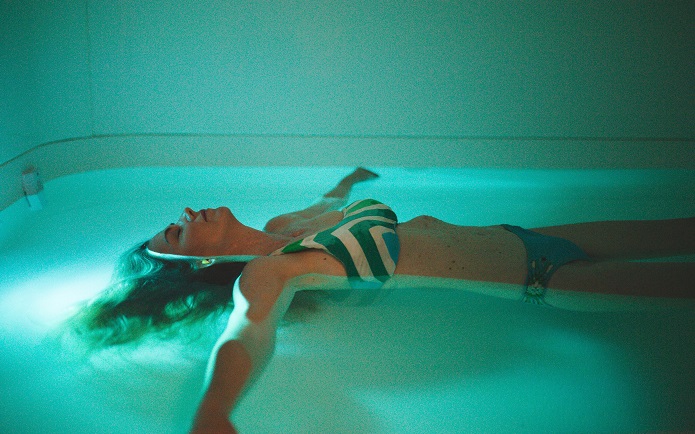A few years ago, I learned that I’m afraid of the dark.
I’d just read an article about how NFL players had been floating in sensory deprivation tanks to boost performance. Now, I’m no Tony Romo, but I’m always curious about wellness trends. So, I decided to take the plunge (no pun intended).
I climbed into the glowing green tank and lowered the lid. Immediately, a sense of calm washed over me. But when the music and lights turned off a few minutes later, I absolutely panicked. I’d never experienced such total darkness and silence.
“Why would anyone pay to do this?” I wondered.
I learned over the next 80-something minutes why floating has become so popular, including among amateur and professional athletes. We’ll get to my path to discovery in a bit. First, let’s discuss how floating can help with athletic performance and recovery.
Float the Jitters Away
To float is to lie in complete darkness and silence in several inches of water, either in a small pod or in an enclosed tub.
The water at FLOAT STL in St. Louis is kept at 93.5 degrees, which is the skin’s approximate surface temperature. This is meant to blur the lines between where the skin ends and the water begins. Hundreds of pounds of Epsom salt make floating effortless while minimizing the amount of skin exposed to air (so you don’t get chilly).
This combination of sensory deprivation and weightlessness has been reported to boost performance and recovery in athletes. But how?
Many athletes experience jitters in the minutes before competition. However, stressing for days and weeks about your performance can be so taxing that it holds you back. Floating can help you get into the right mindset.
“Pre-event nervousness and jitters are using some of your body’s resources,” said Kevin McCulloch, owner of FLOAT STL. “Floating one to two days before an event helps you get into a competition mindset. You can be more rested and less anxious, so that your body’s resources can be used for your desired function.”
No studies have specifically examined the effects of floating on performance. But, one small study this year found it to significantly lower anxiety, stress and muscle tension in people with chronic anxiety and healthy controls alike.
A possible secondary benefit of this is better sleep. A small 2016 study found floating to significantly improve sleep quality in those with chronic anxiety. Again, this hasn’t been studied in the context of performance, but it may be worth a try if you have trouble sleeping before a big event.
As with any change to your training routine, you should never try floating immediately before a key workout or race. Give yourself at least a few days before important athletic events to see how your body reacts.
Float to Heal Post-Race
The potential upsides of floating extend beyond competition prep: it may also help with recovery.
Epsom salt baths have used for centuries to reduce aches and pains. Indeed, small studies have found floating to significantly reduce tension and injury-related muscle pain. The mechanisms for this aren’t fully understood.
Magnesium has been shown to reduce inflammation and ease muscle aches, although studies are mixed as to how much magnesium can be absorbed through the skin. It’s also possible that the sensation of weightlessness relieves pain. As McCulloch points out, your muscles can fully relax when you’re suspended on top of water with no contact to your pressure points.
Joints and muscles aside, floating can be a great way to recover mentally from competition.
“Athletes have a lot of emotion tied to big events,” said McCulloch. “Floating is a great opportunity for reflection, whether that’s gratitude for what your body has accomplished or frustration that you didn’t perform as expected. It can also be an opportunity to close the book on one event and look toward the next.”
Speaking of the mental side of floating, you may be wondering how I made it through my own float.
When panic struck, I began counting my breaths to calm myself down. I was absolutely certain I wouldn’t make it through the next 85 minutes. But after what felt like 5 minutes of breathing, the lights slowly came back on.
“Did the tank malfunction?” I thought.
Then, I realized that my anxiety had forced me into a meditative state. I climbed out of the tank feeling peaceful, ready to float again and fully aware of why athletes would sing its praises.
FLOAT STL offers 60-minute and 90-minute floats in Maryland Heights and in Midtown. More information is available at floatingstl.com.
Author: Kimberly Yawitz is a freelance writer and registered dietitian in St. Louis.


Leave A Comment